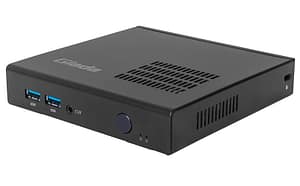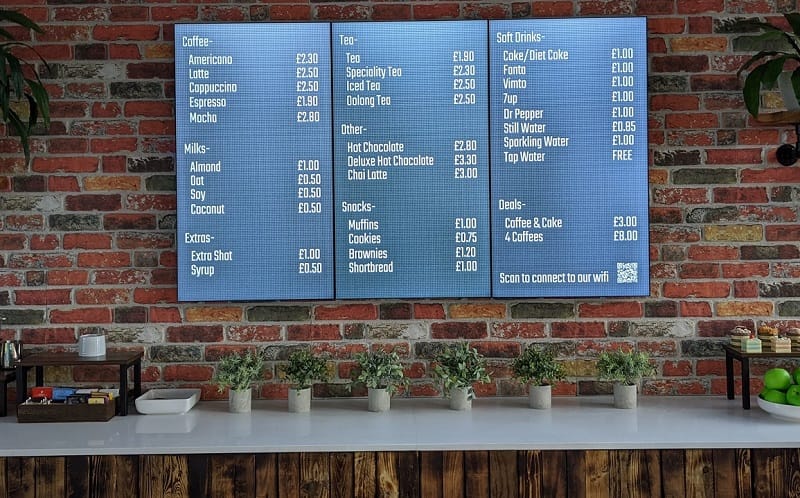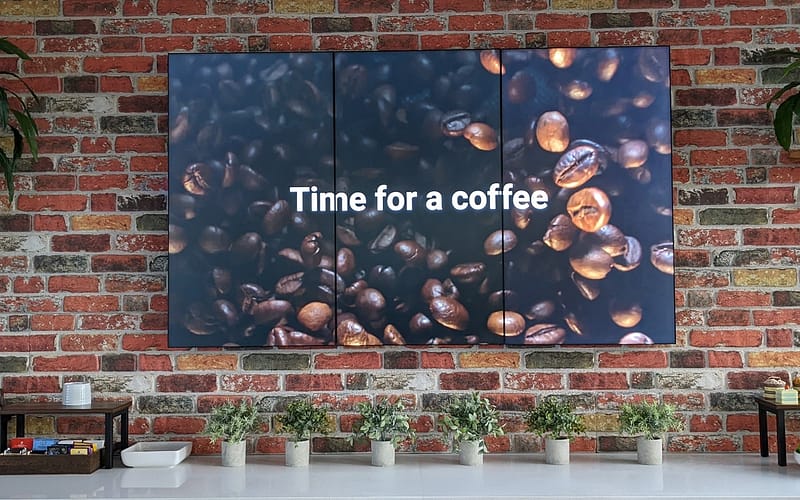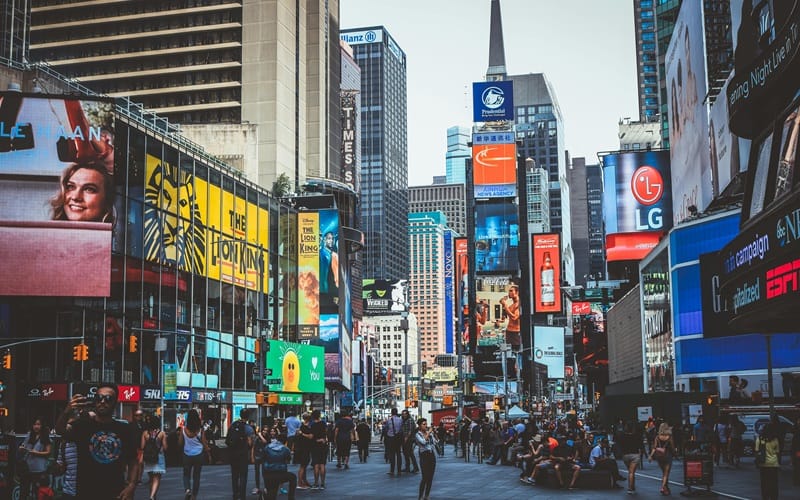We know that digital signage can be a complicated subject, so we’ve put together a list of bitesize digital signage FAQs (Frequently Asked Questions) to help you get all the answers you need in one place.
The basics of digital signage FAQs
Digital signage shows multimedia content like images, video, and text to audiences in a dynamic and visually appealing way. Usually, it requires a combination of a screen/s, media player/s, and software to control what appears and when. It is ideal for communicating promotional and informative content.
- Standard Displays: 32 to 86 inch commercial displays used for things like menu boards, and customer information
- Video Walls: composed of smaller screens positioned together like tiles to create a large, wow-factor display.
- LED Walls: composed of small LED tiles to create a large indoor or outdoor display These are flexible, energy-efficient, and easy to maintain.
- Outdoor Digital Signage: special high/low temperature-resistant displays housed within enclosures to protect them.
- Touchscreen Digital Signage: enable two-way communication (e.g. customer feedback) and transactions.
- Freestanding Digital Signage: can be positioned almost anywhere (indoors or outdoors) and can be temporary or permanently fixed
- High bright: brighter than normal displays and are used to counteract the glare from the sun
With digital signage, you have unlimited promotional space and time. Content changes can be made quickly and consistently. Because it features moving images, digital signage is more dynamic and engaging than static signs. It’s multi-purpose and can be used to provide information and/or collect feedback, which can improve operational efficiency.
Which digital signage is best will depend on your needs. LED walls are easy to maintain and last a long time, but cost more. LCD screens are more cost-effective but use more energy. Touch screens allow user interactivity/feedback but require additional software.
How interactive digital signage is depends on the screen you purchase. Most screens are display only, though you can add a touchscreen overlay. Interactive screens like digital kiosks allow for an engaging and personalised user experience with more flexibility to access informational content, carry out self-service transactions and leave customer reviews.
Whilst there are lots of benefits to using digital signage, disadvantages to be aware of include:
- Initial hardware purchase cost.
- Energy costs to run the hardware.
- Software licensing costs.
- Content creation resource requirement.
- Hardware wear and tear over time.
- Target for vandalism (in unsupervised locations.)
With digital signage, you can show a range of promotional, informative, and interactive content. Alongside your core objectives (e.g., showing prices, promotions, staff/customer updates), consider content that could improve operational efficiency (e.g., opening/closing times, wayfinding info), enhance your brand (company values, CSR activity) or aid recruitment (e.g., vacancies, staff perks).
Yes, digital signage can be used outdoors, but you’ll need a display that can cope with low/high temperatures and the sun’s glare. You can choose from an outdoor LED wall, or a wall-mounted or freestanding display (with a high bright screen) housed in an enclosure to protect against moisture.
There are no specific regulations for using digital signage, but you must follow general health and safety regulations (e.g. electrical equipment, mounting overhead displays properly), adhere to advertising guidelines, not distract or confuse drivers, and only install hardware in places where you have the right/permission to do so.
Digital signage hardware FAQs
Digital signage uses a combination of hardware like commercial LCD or LED screens, media players, mounts/enclosures, as well as content management software to control/display your multimedia content. A reliable internet connection and electrical energy output is also needed. Companies with lots of displays often subcontract technical support and/or content creation.
How you choose digital signage depends on your needs. Key factors include functionality, location, and viewing distance. Consider whether it’ll be used for promotional, informative, or transactional (financial or information) purposes. Will it be used indoors/outdoors/in a vulnerable place? Also consider the display size needed for clear viewing.
Media players are small computers that can be external or built into screens. They’re vital to run the software that controls what appears on your displays and when. Non-dynamic content can be shown using a flash drive, but it’s inadvisable as it limits what can be shown, and content must be changed manually.
As digital signage is designed for commercial use, its components are higher quality than domestic TV’s to prevent overheating/wearing out. Standard hardware manufacturer warranties for screens and media players are usually 3-5 years (though we’ve seen some last 15 years!). Properly maintained, LED walls can last 5-10 years.
It’s possible to use a domestic TV to show non-dynamic content, but it’s inadvisable. TVs can’t run content management software so you can’t show dynamic content or manage your estate remotely. Also, commercial displays are designed to be used 24/7 so they’re better quality and last longer.
Digital menu boards use standard digital signage hardware and software. What turns them into menu boards is the content shown on them. They are very flexible and can show animation, videos, and/or static price lists. They can be interactive to allow self-service purchases, or used outdoors if appropriate hardware/software is used.
Digital menu boards give you more promotional space than static menus, and allow you to use eye-catching animation and product videos. Alongside your standard price list, you can use them to highlight offers, promotions, and product quality, which can increase your average customer spend.
Whilst it’s possible (using non-dynamic content saved on a flash drive) it’s not advisable. Digital signage software (which controls what appears on screen) requires an internet connection to update or change content and to monitor screen ‘health’. NB: Some platforms cache content for continuity in case your internet access fails.
Digital Signage Software FAQs
A digital signage platform is the software you use to manage digital content. Generally speaking, it’s used to create a library of media files, turn them into a playlist, select the time/date or frequency the playlist will appear and whereabouts on screen it will be shown.
A digital signage playlist is a sequence of files containing multimedia content like images, video, text, and sound, which is used to select what will be played back on your digital signage screens, and the order they’ll be played. Playlists can display one form of content at a time or combine many different ones.
A digital signage schedule allows you to decide the date and time your content will be displayed. Schedules also set the length of time that content is displayed for, as well as how frequently it’s shown. Schedules can organise multiple playlists at once.
Digital Signage Costs FAQs
Digital signage costs can vary depending on the type, quality, and specification of the technology and services used. Things you need to budget for are:
- Hardware purchase for displays, media players, mounts or enclosures, cabling, (controllers for LED walls only) and speakers (if required.)
- Installation fees.
- Content management software licensing.
- Ongoing technical support and maintenance costs.
- Content creation.
- Energy costs to keep displays running.
- Wi-Fi costs if accessing the internet.
Although digital signage is becoming more affordable, it’s still fairly expensive. Unlike domestic TVs, commercial digital signage is designed for 24/7 usage, so the components are very high quality to avoid them overheating/wearing out. They also have special features which allow displays to be controlled remotely.
Digital signage terminology FAQs
NIT (also called candela) is a unit of measurement for brightness. It’s used to indicate the quantity of light emitted by a light source (luminance). The units are expressed as candela per square-meter, or cd/m2. One unit of NIT or candela is equivalent to the light emitted by a single candle per square metre.
LUX is a unit of measurement for brightness (lumen per square-metre, or lm/m2.) Rather than indicating the quantity of light emitted by a light source (luminance), LUX indicates the quantity of light which is received from a light source (illuminance.) These two measurements should be the same.







